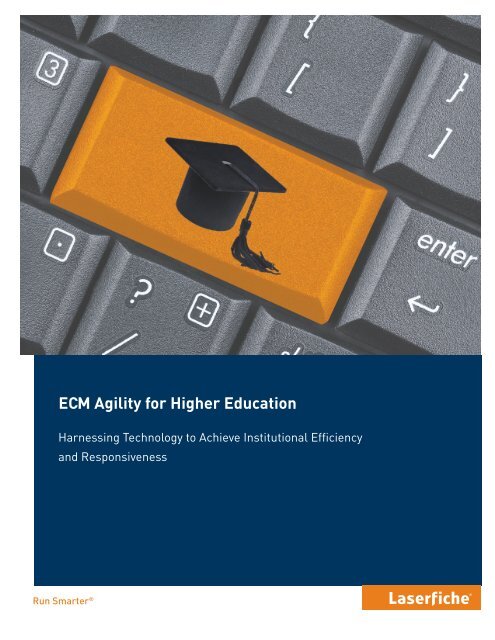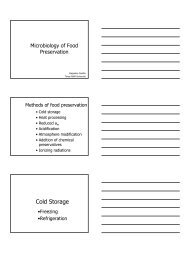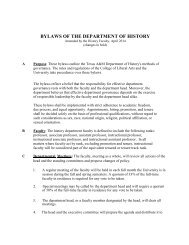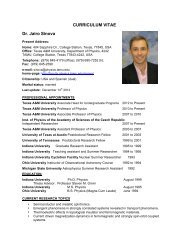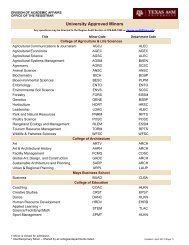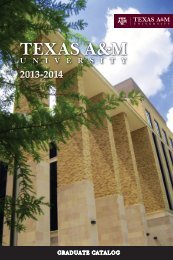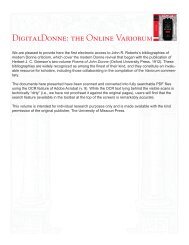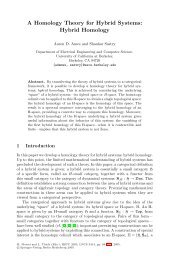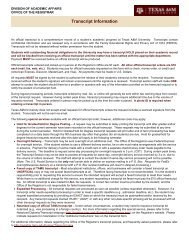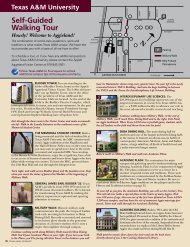ECM Agility for Higher Education - Laserfiche Shared Service ...
ECM Agility for Higher Education - Laserfiche Shared Service ...
ECM Agility for Higher Education - Laserfiche Shared Service ...
You also want an ePaper? Increase the reach of your titles
YUMPU automatically turns print PDFs into web optimized ePapers that Google loves.
<strong>ECM</strong> <strong>Agility</strong> <strong>for</strong> <strong>Higher</strong> <strong>Education</strong>Harnessing Technology to Achieve Institutional Efficiencyand ResponsivenessRun Smarter ®
<strong>ECM</strong> <strong>Agility</strong><strong>for</strong> <strong>Higher</strong> <strong>Education</strong>Harnessing Technologyto Achieve Institutional Efficiencyand Responsivenessi
Table of ContentsIntroduction ......................................................................................................................... 1Agile In<strong>for</strong>mation Management: Standardizing Your Approach ..................................... 3The Dangers of Data Silos ....................................................................................... 3<strong>ECM</strong> at Work on Campus ........................................................................................ 4Agile Business Processes: <strong>ECM</strong> in Everyday Use ........................................................... 5Facilitate Disaster Recovery .................................................................................... 5Enhance Business Office Efficiency ...................................................................... 6Quickly Disburse Financial Aid .............................................................................. 7Centrally Manage Faculty Records ........................................................................... 7Guarantee Student Record Security ....................................................................... 8Facilitate Facilities Management .......................................................................... 8Agile <strong>ECM</strong> Administration: What the IT Department Needs to Know ................................ 9Advice from an IT Manager ................................................................................ 10The <strong>ECM</strong> <strong>Shared</strong> <strong>Service</strong>s Model ............................................................................ 11Business <strong>Agility</strong>: Balancing Flexibility and Control ......................................................... 13Business Benefits ................................................................................................. 13Conclusion ......................................................................................................................... 14iii
IntroductionWith their focus on fostering understandingand creating consensus among faculty, staffand stakeholders, colleges and universities havenot traditionally been known <strong>for</strong> their ability toreact quickly and flexibly to changing conditions.According to the 2010 EDUCAUSE Current ITIssues Survey, however, this is changing. In fact,this year’s survey shows that the issue of “<strong>Agility</strong>,Adaptability and Responsiveness” has becomeeven more important to institutions of higherlearning in 2010 than it was in 2009, pointing tothe value of technology that enables institutionalagility. It also points to the increasingly strategicrole of IT professionals within academicinstitutions, since they are responsible not only<strong>for</strong> evaluating and implementing agile technology,but are now becoming more and more responsible<strong>for</strong> identifying the departments and processes thatcan most benefit from it as well.In its Top 10 IT Issues of 2009 Survey, EDUCAUSEnotes, “Being agile during times of relative calmis challenging enough, but doing so in a rapidlychanging environment requires IT leaders to beaware of the challenges facing the institution atlarge and of how their services help meet thoseneeds.” In other words, knowledge of technologyis no longer enough. Today’s IT professionals mustalso be well-versed in the business, goals andmissions of their academic institutions in order todrive the adoption of the most appropriate, mostagile technology.It’s no surprise, then, that in 2010, EDUCAUSE’sdiscussion evolved beyond “awareness” to“strategic partnership.” This year’s survey notesthat “now more than ever, IT leaders need to bean integral part of campus-wide discussions,” andhighlights the fact that “when departments plan assilos… inevitable conflicts arise.”The Big Picture• To succeed in today’s competitiveand rapidly changing educationalenvironment, the ability to be agile,adaptable and responsive is becomingincreasingly important at colleges anduniversities around the world.• To enable organizational agility, the ITdepartment must become a strategicpartner with a clear vision of theinstitution’s future—and a plan <strong>for</strong> howtechnology can pave the way.• When departments plan as silos,conflicts arise. There<strong>for</strong>e, the ITdepartment should encouragestandardization of systems whereverpossible.• Institutions that use an agile enterprisecontent management (<strong>ECM</strong>) systemto standardize their approach toin<strong>for</strong>mation management increasecollaboration and in<strong>for</strong>mation sharingbetween departments, automate corebusiness processes and minimizeongoing maintenance demands <strong>for</strong> ITpersonnel.• An agile <strong>ECM</strong> system offers individualdepartments and campuses theflexibility to adapt their work processesto changing conditions, increasingorganizational efficiency andresponsiveness.1
To mitigate these conflicts and demonstrate theirstrategic value, IT professionals should encouragestandardization of systems wherever possible.However, they must ensure that the systems theychoose are agile enough to meet the needs ofmany different departments, and flexible enoughto adapt quickly and cost-effectively to changingconditions.This is where enterprise content management(<strong>ECM</strong>) comes into play, specifically agile <strong>ECM</strong>.Agile <strong>ECM</strong> systems allow organizations tocentrally and securely manage all their content—and make it available via a wide range of thirdpartyapplications such as SIS, ERP, billing andmore—while still offering individual departmentsand locations the flexibility to adapt theirwork processes to changing conditions. Andin comparison with traditional <strong>ECM</strong> systemsthat demand extensive domain expertise fromexpensive programmers, analysts and consultants,agile <strong>ECM</strong> systems can be configured locally byin-house line-of-business experts, cutting costswhile simultaneously increasing adaptability andresponsiveness.Kristin Nace, fiscal services director <strong>for</strong> TexasA&M’s Health Science Center, notes that <strong>ECM</strong>“provides an enterprise architecture that haseliminated in<strong>for</strong>mation silos across multiplecampuses by creating a central point of control<strong>for</strong> our records…. I regularly get requests from ourdepartments to set up additional folders, processesor even repositories. I knew people would love theproduct, I just didn’t expect they would love it thismuch.”Leading colleges and universities of all sizesare turning to <strong>ECM</strong> to dramatically improve theproductivity and responsiveness of the entireinstitution. Pressured by regulations and drivenby a clear need to streamline operations, theseinstitutions are harnessing the power of <strong>ECM</strong> to:• Anchor their in<strong>for</strong>mation managementinfrastructures, eliminating departmentalin<strong>for</strong>mation silos and providing timely accessto all relevant content through the applicationsusers know best.• Automate core business processes, improvingstaff productivity and the level of studentservice.• Ease administration and maintenance demandson the IT department by standardizing on anextensible, interoperable and rapidly deployablesolution.This white paper outlines the benefits associatedwith implementing <strong>ECM</strong> <strong>for</strong> individualdepartments, the IT department and the institutionas a whole.2
Agile In<strong>for</strong>mation Management: Standardizing Your Approach with <strong>ECM</strong>As more and more content flows in and out ofcolleges and universities—and as regulatory andcompliance mandates increase—the need to controlunstructured content and improve data governanceis increasing.Enterprise content management has moved waybeyond the old finding-and-filing days to becomea foundational component of data governance.Best-in-class <strong>ECM</strong> is integrative middleware thatexpands organically throughout the institution,crossing departmental boundaries and integratingwith other applications and legacy systems tomanage and process in<strong>for</strong>mation—eliminating datasilos along the way.The Dangers of Data SilosManaging multiple departmental systems isexpensive and complicated <strong>for</strong> IT staff, who haveto keep track of in<strong>for</strong>mation that’s spread overmultiple locations. More often than not, thesesiloed systems end up compounding the problemsthey were supposed to solve.The agile institution values technology thatallows it to be quick, resourceful and adaptable,rapidly and consistently delivering results in theface of uncertainty and change. It recognizes thatdata silos prevent key stakeholders from gaininga holistic view of the institution’s prioritiesand per<strong>for</strong>mance. There<strong>for</strong>e, it seeks <strong>ECM</strong> thatis built on an open architecture—maximizinginteroperability and simplifying integration withexisting systems in multiple departments andlocations. For example, <strong>ECM</strong> that is built on theWindows Workflow Foundation (WF) allows ITprofessionals to integrate primary applications andexisting workflows into <strong>ECM</strong> workflows using WFand the .NET framework.Eliminating in<strong>for</strong>mation silos sometimes raisesconcerns about data security, but data silos do notprotect confidential in<strong>for</strong>mation. On the contrary,they complicate in<strong>for</strong>mation security by requiringIT staff to manage data in multiple systems. Agile<strong>ECM</strong> systems have robust, role-based securityfeatures that prevent unauthorized departments andemployees from accessing protected in<strong>for</strong>mation.And by centralizing control of records spreadacross disparate content repositories, institutionsensure that data is consistent, reliable, useful andavailable, simplifying enterprise risk managementand compliance.By standardizing on an agile <strong>ECM</strong> system, academicinstitutions boost per<strong>for</strong>mance by increasingin<strong>for</strong>mation accessibility and security acrosscampus, eliminating data silos and enabling keystakeholders to make better-in<strong>for</strong>med decisions.Robson Agnew, <strong>for</strong>mer records manager at theUniversity of British Columbia, notes that whenit comes to standardization, “The more folks youhave using [your <strong>ECM</strong> system], the more benefitsyou realize from it. Although most departmentsact independently when it comes to their softwaredecisions, in fact, we’re all interconnected. Aunified <strong>ECM</strong> system is a great thing <strong>for</strong> anyuniversity.”3
<strong>ECM</strong> at Work on Campus<strong>ECM</strong> has many benefits beyond those described in this white paper. The following diagram provides a quickoverview of how <strong>ECM</strong> can help specific departments on campus.4
Agile Business Processes: <strong>ECM</strong> in Everyday UseStandardizing on <strong>ECM</strong> doesn’t just provide aconsistent way of viewing, storing and accessingin<strong>for</strong>mation, it also gives the institution acentralized, flexible and secure way to createautomated, repeatable processes in everydepartment.With <strong>ECM</strong>, user rights and privileges can beconfigured so that individual schools, departmentsand even individual users retain control over theirown filing structures and business processes, whilethe IT department retains central control overin<strong>for</strong>mation storage, disposition and security. Notonly does this speed and simplify collaborationby automating content-related activities, it offerscentralized control of records and ensures that datais consistent, reliable, useful and available. In thisway, standards and security are en<strong>for</strong>ced, but noone is compelled to adopt an aggravating or timeconsumingnew practice that does not make sense<strong>for</strong> a particular situation.Agile, intuitive <strong>ECM</strong> that balances central controlwith local flexibility helps institutions of higherlearning provide better service and respondrapidly and flexibly to changing conditions. Morespecifically, <strong>ECM</strong> enables colleges and universitiesto:• Facilitate disaster recovery.• Enhance business office efficiency.• Quickly disburse financial aid.• Centrally manage faculty records.• Guarantee student record security.• Automate accounts payable processing.• Facilitate facilities management.Facilitate Disaster RecoveryIt’s crucial <strong>for</strong> colleges and universities to plan andprepare <strong>for</strong> operational interruptions. Agile <strong>ECM</strong>plays a key part in disaster recovery planning,securing records and limiting the cost and ef<strong>for</strong>t ofsalvage and restoration.• Ensure that administrators, maintenanceemployees and local police and fire departmentscan instantly access critical documents—including building plans, E-sized drawings andmaintenance <strong>for</strong>ms—via the Web in case of anemergency.• Protect against file loss and damage in the case ofa fire, flood, theft or other disaster.• Organize architectural drawings, schematicsand operations manuals by school so they’reeasily accessible in times of crisis.• Instantly reconstruct damaged or destroyedrepositories and provide immediate access toauthorized personnel.Monica Baccardax, IT project manager <strong>for</strong> theFaculty of Medicine at Dalhousie UniversityMedical School, notes that it was a huge relief tostaff “when they realized that our <strong>ECM</strong> systemserves as a backup should documents be destroyed.They no longer [had to] worry about losing paperdocuments.”Meanwhile, David Haugland, associate viceprovost at the University of Southern Cali<strong>for</strong>nia(USC), explains that “Disaster recovery has reallybeen the catalyst <strong>for</strong> enterprise-wide adoption of<strong>ECM</strong>.”5
Enhance Business Office EfficiencyThe business office—responsible <strong>for</strong> recruitingnew faculty and staff, administering payroll,managing contracts and grants and dealing withcorrespondence—must deal with a large volume ofdocuments every day. Using agile <strong>ECM</strong> increasesefficiency and cuts costs by eliminating paper-basedprocesses, improving in<strong>for</strong>mation accessibility anddecreasing the need to store paper documents.• Automate key business processes such as accountspayable processing, agenda management andcontract management, among others.• Improve staff productivity by removing the need<strong>for</strong> time-consuming manual filing.• Increase transparency by providing a securepublic portal that grants vendors, reporters andother interested parties with access toin<strong>for</strong>mation.• Digitize and barcode timesheets <strong>for</strong> easy storageand retrieval.• Free up space <strong>for</strong> faculty offices or classrooms byeliminating the need <strong>for</strong> file cabinets.• Cut costs by decreasing the need <strong>for</strong> overnightshipping and mailing.The Chancellor’s Office at a large university inSouthern Cali<strong>for</strong>nia scans, indexes and distributesthe university’s incoming mail using an agile<strong>ECM</strong> system, giving approximately 150 staff andfaculty members across campus instant access torelevant items. The university’s communicationscoordinator notes that mail gets to recipientsmuch faster than it did when people had to deliverhard copies around campus by hand. She alsoappreciates the fact that the <strong>ECM</strong> system allowsreaders to annotate documents so that otherrecipients can quickly see if there is any follow-upaction that needs to be taken.Spotlight on Accounts Payable ProcessingIn the Chancellor’s Office at Cali<strong>for</strong>nia State University, the accounting department uses the businessprocess management (BPM) tools in its agile <strong>ECM</strong> suite to automate accounts payable processing asfollows:• An invoice is scanned into the system.• <strong>Laserfiche</strong> Workflow automatically routes it to an approver, who receives notification via e-mail.• Approvers access the invoice by clicking on the link in the e-mail, opening their Approver Folders in<strong>Laserfiche</strong> and double clicking on the invoice.• After reviewing the invoice, approvers provide payment in<strong>for</strong>mation (or explain why payment is denied)by inserting sticky notes with purchase order and/or chartfield in<strong>for</strong>mation.• Using a drop-down menu, approvers either approve or deny payment.• Workflow then automatically routes the invoice back to the A/P technicians.• <strong>Laserfiche</strong> Quick Fields extracts index field data from the invoice. An integration with the university’sA/P system allows <strong>Laserfiche</strong> to autopopulate additional fields, eliminating the need <strong>for</strong> manual dataentry into <strong>Laserfiche</strong>.“<strong>Laserfiche</strong> is very user friendly, and the automation saves our staff a lot of time,” says Terry Hamilton,the <strong>for</strong>mer A/P manager who served as the project lead in USC’s Chancellor’s Office.“One huge advantage of <strong>Laserfiche</strong> over other <strong>ECM</strong> systems,” Hamilton adds, “is that it is very easy <strong>for</strong>system administrators to add template fields, which adds a lot of flexibility to adapt to changes in theway we process our invoices. <strong>Laserfiche</strong> also tracks changes to documents and keeps a record of whohas seen or worked on any given invoice, increasing the level of control we have over document security.”6
“I call them ‘the gold files’ because they’re such goldto me,” says Brown. “Something that used to taketen minutes to find, now it’s a matter of seconds.”Many other schools and departments within USChave adopted <strong>Laserfiche</strong> as a result of the ProvostOffice’s success, including Marshall School ofBusiness, Keck School of Medicine, the Collegeof Letters, Arts & Sciences, Career and Protective<strong>Service</strong>s and Facility Management, among others.Guarantee Student Record SecurityAdministering records access under FERPAconsumes staff time. An agile <strong>ECM</strong> system withgranular security functionality helps you designand implement a security policy that works withinyour existing environment to balance documentcompliance, security and accessibility.• Implement DoD 5015.2-certified recordsmanagement to simplify compliance withrecordkeeping requirements.• Eliminate misplaced files, files lost in transitfrom off-site records storage facilities andinappropriately accessed files.• Control confidential records, and prevent themfrom showing up in a repository search.• Guarantee security all the way down to individualwords with blackout and whiteout redactions.• Log system activity to demonstrate compliancewith regulations.The Dalhousie University Medical Schooldiscovered that an agile <strong>ECM</strong> system enables staff toquickly and reliably access student records withoutburdening them with complicated and timeconsumingnew ways of working with files. Thesystem was structured to mirror the filing hierarchyand classification codes that were already in place.Dalhousie’s Baccardax notes that when it comes tostudent records and federal regulations, “certaintypes of in<strong>for</strong>mation cannot be shared unlessapproved by an authorized person. Our <strong>ECM</strong>system enables us to set the access rights so thatin<strong>for</strong>mation is available only to authorized staff.”Facilitate Facilities ManagementWhether you work at a small, private collegeor a statewide university system, managing theinstitution’s facilities is a big job. Responsible<strong>for</strong> ensuring the planning, design, construction,operation and maintenance of all buildings andgrounds, this department benefits from using anagile <strong>ECM</strong> system that:• Organizes architectural drawings, schematics,safety documents, sustainability reports andoperations manuals by school so they’re easilyaccessible.• Enables staff to retrieve blueprints, maps andE-sized drawings onsite from wireless-enabledlaptops.• Automates the project approval process, allowingsupervisors to easily prioritize work requestsaccording to urgency.• Uses audit trails to monitor and reportsystem activity to administrators.• Assigns security rights and privileges by group orindividual user.According to <strong>for</strong>mer Records Manager RobsonAgnew, the land and buildings department at theUniversity of British Columbia uses <strong>Laserfiche</strong>WebLink to grant its tradespeople read-only accessto documents: “Our tradespeople access manualsand plans from the system using WebLink, whileour ‘power users’ have the security rights to retrievepretty much whatever they need.”8
Agile <strong>ECM</strong> Administration: What the IT Department Needs to KnowLong deployment schedules and a lack of systemsinteroperability present two key challenges to thesuccessful implementation of technology on collegeand university campuses. Un<strong>for</strong>tunately, the <strong>ECM</strong>marketplace is rife with solutions that are difficultto deploy, confusing to configure and complex toadminister. This is why it is essential to stay awayfrom vendors that have cobbled together a set ofcomplicated tools that require major investmentsin programming or professional services.Furthermore, agile <strong>ECM</strong> systems offer rapiddeployment, streamlined development and easyintegration with a wide range of applications suchas:• Accounting.• Enterprise resource planning.• Student in<strong>for</strong>mation systems.• Mainframe/database applications.By selecting agile <strong>ECM</strong> tools that can be configuredlocally yet controlled centrally, the institution givesindividual departments the ability to configurelocal solutions and avoids using consultants,programmers and in-house IT staff <strong>for</strong> all but themost strategic <strong>ECM</strong> tasks.Agile <strong>ECM</strong> solutions are engineered <strong>for</strong>maximum scalability, interoperability and ease ofadministration. Maintenance is simple becauseagile <strong>ECM</strong> systems provide extensive support <strong>for</strong>standard Windows administrative tools such asMMC, Event Tracing <strong>for</strong> Windows, WMI and theWindows Event Log. Flexible configuration allowsdepartmental databases to reside in separatelocations with individualized security settings.9
Advice on <strong>ECM</strong> Adoption from an IT ManagerDennis Raulie, manager of the administrative computing technology services department at Texas A&MUniversity Corpus Christi, has had great success streamlining his institution’s business processes andreducing its paper consumption with <strong>Laserfiche</strong>. He has a few words of wisdom to share with other ITmanagers looking to implement an agile <strong>ECM</strong> system:• Don’t <strong>for</strong>get about end users when you’re evaluating systems. No matter how many business benefitsan <strong>ECM</strong> system can deliver, if end users don’t buy into the new solution, it will sit on the shelf collectingdust. To help staff get up to speed quickly, look <strong>for</strong> an <strong>ECM</strong> system that includes familiar Windowsfeatures, such as right-click menus and flexible folder structures. “Our users liked the simplicity andspeed of <strong>Laserfiche</strong>. They also liked the ease of use. It was a much more intuitive <strong>ECM</strong> system thanthey were used to,” Raulie states.• Change can be hard, so aim first <strong>for</strong> small victories that win internal champions and inspire organicadoption—not just demand it. For Raulie’s first project, he targeted the institution’s accountingdepartment, where hundreds of data <strong>for</strong>ms a day were printed, scanned and manually indexedby student workers. In the past, staff were often a month behind in the filing. Since implementing<strong>Laserfiche</strong>, however, the department is now working in real time. “Get people like that com<strong>for</strong>tablyproductive and enthusiastic,” advises Raulie. “They talk about the success and the word spreads.”• Solicit input from department and unit managers to increase group ownership of the project, andobtain administrative buy-in with regular progress updates. “Department managers are the teammembers who ‘know the flow.’ Their input is crucial.” Updating administrators with reports of thesuccess and progress of the implementation is also a key component. “It’s not bragging if it’s true,”Raulie notes.• Create a test environment where users can experience the software at their own pace. “Build a‘sandbox’ repository <strong>for</strong> users to play in and let them learn the controls,” he says.• Offer continuous training opportunities <strong>for</strong> your users. “If you think the price of training is too high,consider the price of ignorance,” he warns. Raulie recommends taking advantage of training videos,technical white papers, <strong>for</strong>ums and other training materials available on the <strong>Laserfiche</strong> Support Site.• Customize the <strong>ECM</strong> system to fit your specific needs. Using the <strong>Laserfiche</strong> Software Developer’s Kit(SDK), Raulie and his team created a “Report Upload Bifurcation Engine” that processes continuousBFF/FAMIS report files, and splits them into individual reportlets that are uploaded into <strong>Laserfiche</strong>.“In the hands of someone who knows Visual Basic, [creating processes like this] should be a snap,” hesays.10
A Simple <strong>Shared</strong> <strong>Service</strong>s Maturity ModelWhen setting up shared services delivery with your <strong>ECM</strong> system, it’s critical to know where to start,where you want to go and how you are going to get there. This can be done using a maturity model, whichoffers a pathway of best-practice milestones. Here is an example of a simple shared services maturitymodel:• Localize your best practices. Analyze the processes conducted by different departments and calculatetheir lowest common denominator. Figure out which process is most efficient—and then make itrepeatable so you can roll it out to the entire organization. Many colleges and universities start withprocesses conducted by multiple departments such as hiring or contracts.• Thoughtfully standardize across the institution. Although standardization can have a utopian veneer,it’s best to be ruthlessly practical. Look at your metadata models, and consider implementing a mastermodel like the Dublin Core Set. On the delivery side, develop a standardized skill set <strong>for</strong> your staff. Thisallows you to bundle competencies and refine your service culture.• Consolidate. A very wise technology deployment expert once explained that the key to excellencein in<strong>for</strong>mation delivery is to standardize the central system and customize the delivery. This allowsin<strong>for</strong>mation access to be dynamic. Deployment-wise this means consolidating all of your content intoone <strong>ECM</strong> system and integrating to allow the users to access content through any application. Theinterfaces through which staff accesses the <strong>ECM</strong> system are customized based on their needs ordepartmental roles.• Cost benefits. This is where the economies of scale kick in. You’ve developed your service levelagreements and are rolling out a menu of <strong>ECM</strong> functions in terms of head-count. At this stage yourfocus is no longer just internal optimization. You are actually creating value <strong>for</strong> the institution throughyour service offerings.• Continuous review. Now that you’ve optimized your processes and developed your skill set, you mustconstantly refine your menu of offerings. Auditing is continuous and proactive. Quality improvementsare implemented using <strong>for</strong>malized change management processes like Six Sigma.12
Business <strong>Agility</strong>: Balancing Flexibility and ControlColleges and universities have always struggledto balance centralized control with departmentalautonomy. On one side lie the back-officepolicies and support systems that govern howwork is done. These systems are designed tomake the institution more efficient and may bemandated by leadership or required by law. Onthe other side sit knowledge workers, equippedwith skills and expertise developed throughyears of experience. These managers andfrontline employees understand the importanceof process, but they bristle under too much topdowndiscipline. They want the freedom andflexibility to create their own processes—andstudy after study shows that the more employeesfeel empowered, the more productive they tendto be.According to recent research conducted byThe Economist Intelligence Unit, 80% of theorganizations that have implemented <strong>for</strong>malinitiatives to improve business processes over thepast three years have faced employee resistance.Three major causes of this reluctance to changewere:• The new process added more work (31%).• Employees had little or no say in determiningthe new process (31%).• The new process didn’t map to the wayemployees thought their jobs should be done(28%).By granting individual facilities, departmentsand users control over their own filingstructures and business processes, agile <strong>ECM</strong>solutions enable colleges and universities toneutralize these objections to change. A centralcommittee establishes templates and standards<strong>for</strong> managing content, and then local decisionmakers determine the best ways to work with itwithin their individual groups.In this way, filing structures and automatedworkflows can readily be configured to mirrorexisting processes and procedures, guaranteeingswift system acceptance and enthusiastic use.Local decision makers are also able to easilymake changes to their processes and filingstructures midstream in order to meet changingbusiness or market conditions, all withoutsacrificing the institution’s control over itsin<strong>for</strong>mation infrastructure—or having to possessdeep technical expertise.Business BenefitsIn addition to the benefits that accrue to thevarious departments that use the agile <strong>ECM</strong>system, the institution as a whole will also gain:• Elimination of data silos. Data silos aredangerous <strong>for</strong> many reasons, but primarilybecause they prevent key stakeholders fromgaining a holistic view of the institution’spriorities and per<strong>for</strong>mance. Best-in-class <strong>ECM</strong>systems are built on an open architectureto maximize interoperability and simplifyintegration with existing systems in multipledepartments and locations. By increasingin<strong>for</strong>mation accessibility and collaborationthroughout the institution, colleges anduniversities boost per<strong>for</strong>mance by enablingkey stakeholders to make better-in<strong>for</strong>meddecisions.• Increased security. Stringent privacy lawsdictate that colleges and universities protectstudent and faculty in<strong>for</strong>mation. <strong>ECM</strong> storesthis in<strong>for</strong>mation in a secure repository thatlimits access by user, folder, document and/or data field. Agnew notes that <strong>Laserfiche</strong>allows “different folks to have different levelsof access. <strong>Laserfiche</strong> makes it easy to set up,whether we’re determining security by user—say by an individual staff member—or bygroup.”13
The <strong>Laserfiche</strong> Institute teaches staff, resellers, and current and prospective clients how to use<strong>Laserfiche</strong> most effectively. As part of this mission, the Institute conducts more than 500 Webinarseach year, covering a variety of topics. The Institute also hosts an annual conference where membersof the <strong>Laserfiche</strong> community attend presentations and network to share ideas and learn best practices.Additionally, the Institute conducts a number of regional training sessions and provides resellerswith content <strong>for</strong> more than 100 user conferences each year.The Institute also develops and distributes educational material through the <strong>Laserfiche</strong> SupportSite. On this Website, clients can access training videos, participate in online <strong>for</strong>ums and downloadtechnical papers and presentations that help them become savvier <strong>ECM</strong> users.For more in<strong>for</strong>mation, contact:info@laserfiche.com<strong>Laserfiche</strong>3545 Long Beach Blvd.Long Beach, CA 90807United StatesPhone: 562-988-1688Toll-free: 800-985-8533 (within the U.S.)Fax: 562-988-1886Web: www.laserfiche.com© 2010 <strong>Laserfiche</strong>. <strong>Laserfiche</strong> is a division of Compulink Management Center, Inc. <strong>Laserfiche</strong> is a registered trademark of Compulink ManagementCenter, Inc. All other trademarks are properties of their respective companies. Due to continuing product development, product specificationsand capabilities are subject to change without notice. Printed in the USA.
<strong>Laserfiche</strong>3545 Long Beach Blvd.Long Beach, CA 90807 USAwww.laserfiche.comRun Smarter ®


